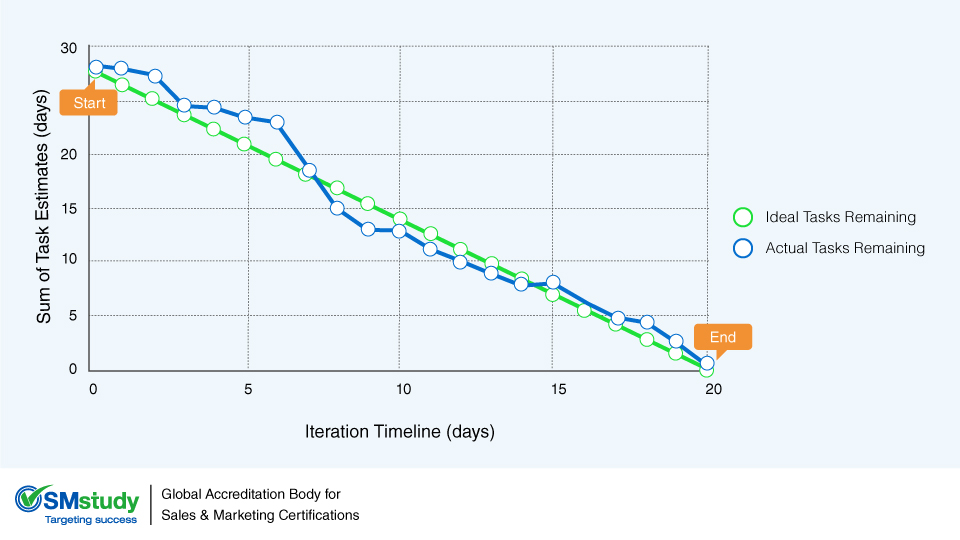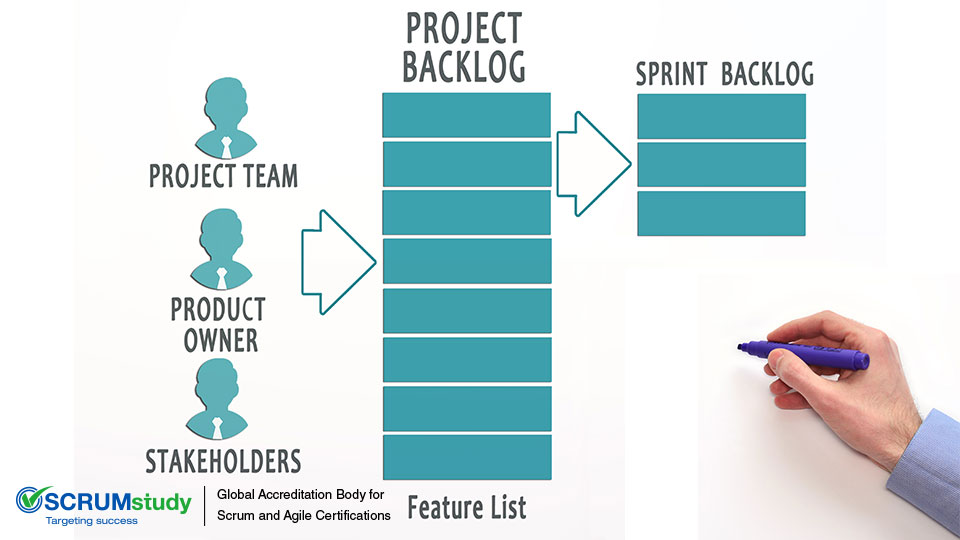How do you adjust the sprint backlog in Scrum methodology?
Posted by SCRUMstudy® on March 05, 2024
Categories: Agile Product Backlog Product Development Scrum Sprint
In the world of Agile project management, the Sprint Backlog plays a crucial role in ensuring teams stay focused, organized, and adaptable. This article delves into the intricacies of the Sprint Backlog in Scrum, highlighting the importance of refinement and how it contributes to efficient sprint planning and execution. Let's explore how Agile teams can leverage the Sprint Backlog to enhance productivity and deliver value consistently.
Scrum methodology places significant emphasis on backlog refinement to ensure the sprint backlog contains items that are well-defined, prioritized, and achievable within the sprint timeframe.
What is a Sprint Backlog? Is it a baseline, a record or a report? Baseline is a project document, which, defines aspects of the project and, once approved, is subject to change control. It is used to measure a project’s actual performance as against planned targets. A record maintains information on the progress of the project. A report provides snapshots of the status of different aspects of a project at any given point of time or for a given duration.
To answer this question, we need to understand what a Sprint Backlog is, its purpose and composition. The Scrum Team creates the Sprint Backlog and Sprint Burndown Chart using the User Stories, and the Updated Task List during Sprint Planning Meeting. During Sprint Planning Meeting, the User Stories, which are approved, estimated, and committed during the Create, Estimate, and Commit User Stories process, are taken up for discussion by the Scrum Team. Each Scrum Team member also uses Updated Task List to select the tasks they plan to work on in the Sprint, based on their skills, and experience. The list of the tasks to be executed by the Scrum Team in the upcoming Sprint is called the Sprint Backlog.
It is common practice in Scrum that the Sprint Backlog is represented on a Scrumboard or task board, which provides a constantly visible depiction of the status of the User Stories in the backlog. Also included in the Sprint Backlog are any risks associated with the various tasks. Any mitigating activities to address the identified risks would also be included as tasks in the Sprint Backlog. Once the Sprint Backlog is finalized and committed to by the Scrum Team, new user stories should not be added – however, tasks that might have been missed or overlooked from the committed user stories may need to be added. If new requirements arise during a Sprint, they will be added to the overall Prioritized Product Backlog and included in a future Sprint, depending on their criticality, and urgency.
In Scrum methodology, the Sprint Backlog adjustment process is crucial for maintaining focus and adaptability throughout the sprint. As defined by SCRUMstudy, the Sprint Backlog represents the subset of prioritized items from the Product Backlog that the Scrum Team commits to delivering during the sprint. Adjustments to the Sprint Backlog may occur during the Sprint Planning Meeting or throughout the sprint as new insights or priorities emerge. This iterative adjustment ensures that the team remains aligned with the sprint goal and can respond effectively to changes in requirements or unforeseen challenges. By regularly reviewing and refining the Sprint Backlog, teams optimize their ability to deliver valuable increments of work while maintaining flexibility and responsiveness within the Scrum framework.
Another tool associated with the Sprint Backlog is the Sprint Burndown Chart. It is a graph that depicts the amount of work remaining in the ongoing Sprint. The initial Sprint Burndown Chart is accompanied by a planned burndown. The Sprint Burndown Chart should be updated at the end of each day as work is completed. This chart shows the progress that has been made by the Scrum Team and also allows for the detection of estimates that may have been incorrect. If the Sprint Burndown Chart shows that the Scrum Team is not on track to finish the tasks in the Sprint on time, the Scrum Master should identify any obstacles or impediments to successful completion, and try to remove them. A related chart is a Sprint Burnup Chart. Unlike the Sprint Burndown Chart which shows the amount of work remaining, the Sprint Burnup Chart depicts the work completed as part of the Sprint.
So, it is difficult to categorize the Sprint Backlog as a baseline, record or a report. And as Scrum professes minimum documentation, Sprint Backlog fulfills purposes of more than one project document. For more information on Scrum framework, you can read the Scrum Body of Knowledge (SBOK Guide). It can be downloaded for free in SCRUMstudy website: http://www.scrumstudy.com/download-free-buy-SBOK.asp
The Value of the Sprint Backlog in Scrum Projects
Posted by SCRUMstudy® on January 07, 2023
Categories: SBOK® Guide
What is a Sprint Backlog? Is it a baseline, a record, or a report? A baseline is a project document that defines aspects of the project and, once approved, is subject to change control. It is used to measure the project’s actual performance against planned targets. A record maintains information on the progress of the project. A report provides snapshots of the status of different aspects of a project at a given point in time or for a given duration.
To answer this question, we need to understand what a Sprint Backlog is, its purpose and composition. The Scrum Team creates the Sprint Backlog and Sprint Burndown Chart using the User Stories and the Effort Estimated Task List during Sprint Planning Meeting. During Sprint Planning Meeting, the User Stories, which are approved, estimated, and committed during the Approve, Estimate, and Commit User Stories process, are taken up for discussion by the Scrum Team. Each Scrum Team member also uses Effort Estimated Task List to select the tasks they plan to work on in the Sprint, based on their skills and experience. The list of the tasks to be executed by the Scrum Team in the upcoming Sprint is called the Sprint Backlog.
It is common practice in Scrum that the Sprint Backlog is represented on a Scrumboard or task board, which provides a constantly visible depiction of the status of the User Stories in the backlog. Also included in the Sprint Backlog are any risks associated with the various tasks. Any mitigating activities to address the identified risks would also be included as tasks in the Sprint Backlog. Once the Sprint Backlog is finalized and committed to by the Scrum Team, new user stories should not be added – however, tasks that might have been missed or overlooked from the committed user stories may need to be added. If new requirements arise during a Sprint, they will be added to the overall Prioritized Product Backlog and included in a future Sprint.
Another tool associated with the Sprint Backlog is the Sprint Burndown Chart. It is a graph that depicts the amount of work remaining in the ongoing Sprint. The initial Sprint Burndown Chart is accompanied by a planned burndown. The Sprint Burndown Chart should be updated at the end of each day as work is completed. This chart shows the progress that has been made by the Scrum Team and also allows for the detection of estimates that may have been incorrect. If the Sprint Burndown Chart shows that the Scrum Team is not on track to finish the tasks in the Sprint on time, the Scrum Master should identify any obstacles or impediments to successful completion, and try to remove them. A related chart is a Sprint Burnup Chart. Unlike the Sprint Burndown Chart which shows the amount of work remaining, the Sprint Burnup Chart depicts the work completed as part of the Sprint.
So, categorizing the Sprint Backlog as a baseline, record, or report proves challenging. As Scrum advocates for minimal documentation, the Sprint Backlog serves multiple purposes akin to various project documents. For further insights into the Scrum framework, you can access the Scrum Body of Knowledge (SBOK Guide) for free on the SCRUMstudy website: http://www.scrumstudy.com/download-free-buy-SBOK.asp
Sprint Backlog in Scrum
Posted by SCRUMstudy® on October 22, 2022
Categories: Agile Product Backlog Product Development Scrum Sprint
What is a Sprint Backlog? Is it a baseline, a record or a report? Baseline is a project document, which, defines aspects of the project and, once approved, is subject to change control. It is used to measure a project’s actual performance as against planned targets. A record maintains information on the progress of the project. A report provides snapshots of the status of different aspects of a project at any given point of time or for a given duration.
To answer this question, we need to understand what a Sprint Backlog is, its purpose and composition. The Scrum Team creates the Sprint Backlog and Sprint Burndown Chart using the User Stories, and the Updated Task List during Sprint Planning Meeting. During Sprint Planning Meeting, the User Stories, which are approved, estimated, and committed during the Create, Estimate, and Commit User Stories process, are taken up for discussion by the Scrum Team. Each Scrum Team member also uses Updated Task List to select the tasks they plan to work on in the Sprint, based on their skills, and experience. The list of the tasks to be executed by the Scrum Team in the upcoming Sprint is called the Sprint Backlog.
It is common practice in Scrum that the Sprint Backlog is represented on a Scrumboard or task board, which provides a constantly visible depiction of the status of the User Stories in the backlog. Also included in the Sprint Backlog are any risks associated with the various tasks. Any mitigating activities to address the identified risks would also be included as tasks in the Sprint Backlog. Once the Sprint Backlog is finalized and committed to by the Scrum Team, new user stories should not be added – however, tasks that might have been missed or overlooked from the committed user stories may need to be added. If new requirements arise during a Sprint, they will be added to the overall Prioritized Product Backlog and included in a future Sprint, depending on their criticality, and urgency.
Another tool associated with the Sprint Backlog is the Sprint Burndown Chart. It is a graph that depicts the amount of work remaining in the ongoing Sprint. The initial Sprint Burndown Chart is accompanied by a planned burndown. The Sprint Burndown Chart should be updated at the end of each day as work is completed. This chart shows the progress that has been made by the Scrum Team and also allows for the detection of estimates that may have been incorrect. If the Sprint Burndown Chart shows that the Scrum Team is not on track to finish the tasks in the Sprint on time, the Scrum Master should identify any obstacles or impediments to successful completion, and try to remove them. A related chart is a Sprint Burnup Chart. Unlike the Sprint Burndown Chart which shows the amount of work remaining, the Sprint Burnup Chart depicts the work completed as part of the Sprint.
So, it is difficult to categorize the Sprint Backlog as a baseline, record or a report. And as Scrum professes minimum documentation, Sprint Backlog fulfills purposes of more than one project document. For more information on Scrum framework, you can read the Scrum Body of Knowledge (SBOK Guide). It can be downloaded for free in SCRUMstudy website: http://www.scrumstudy.com/download-free-buy-SBOK.asp


